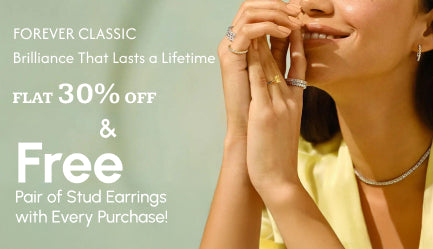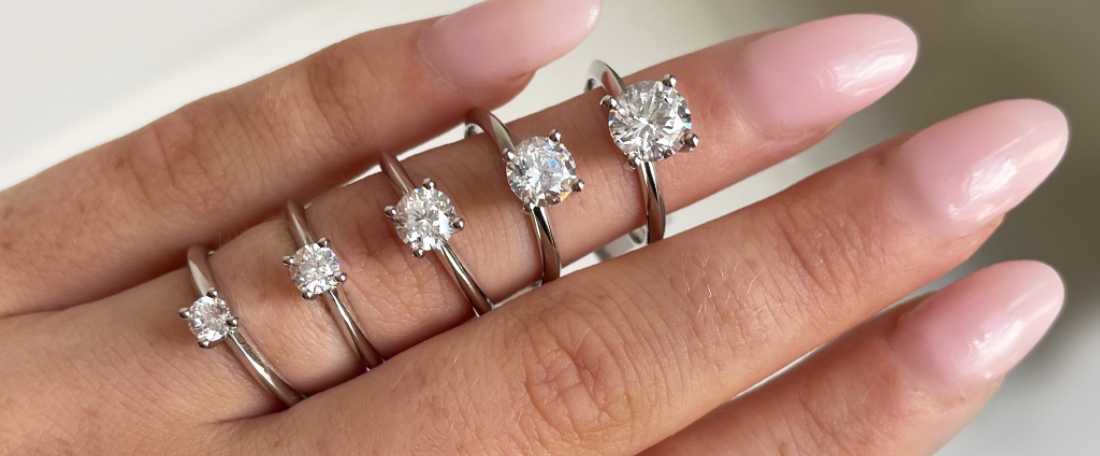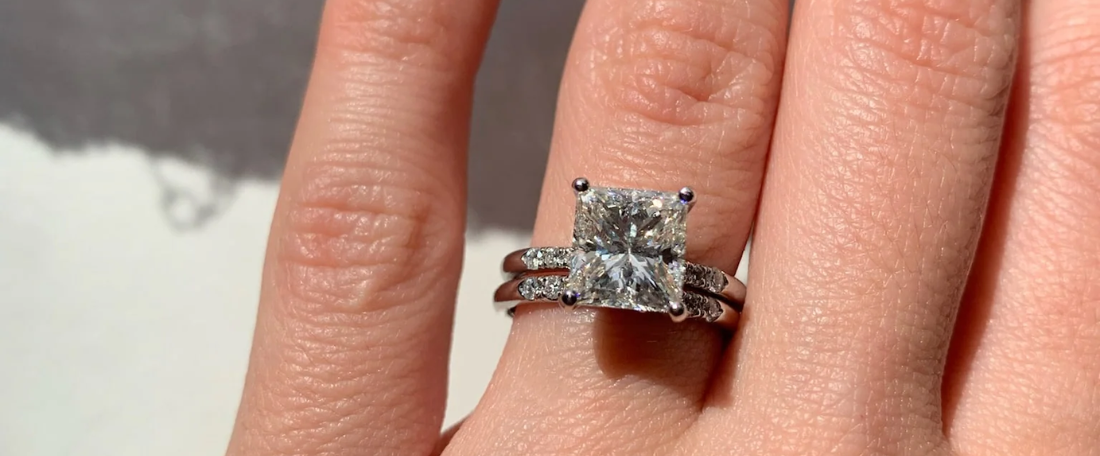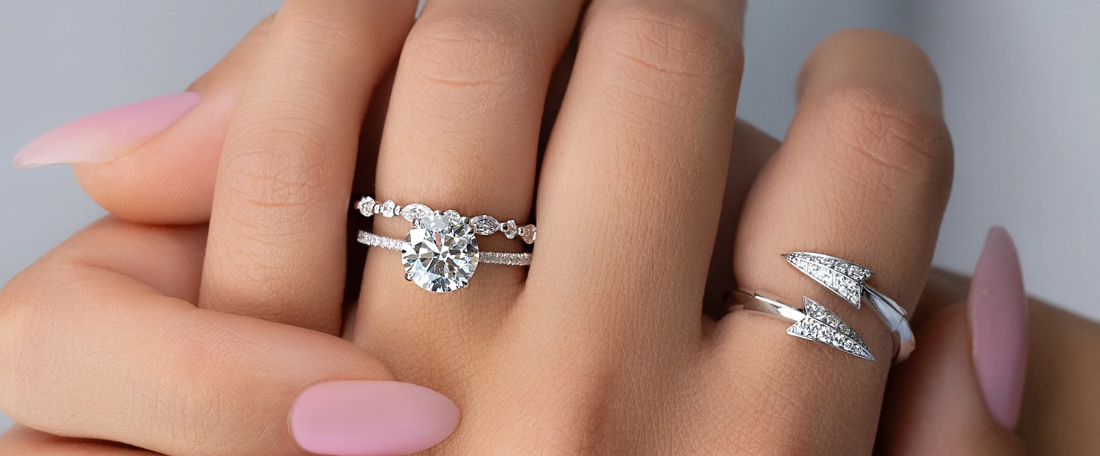Three-stone engagement rings (also called trilogy or trinity rings) are far more than a center stone flanked by two companions. They’re a story set in metal and gem — a sentimental trio that captures memory, meaning, and style all at once. Whether you're shopping for a proposal, upgrading a family heirloom, or curating a ring that’ll be worn daily, this guide will walk you through symbolism, styles, and smart buying tips — in plain English, with no jewellery-speak overload. Ready? Let’s dive in.
What Is a Three-Stone Engagement Ring?
The basic structure: center stone + two side stones
A three-stone ring features one prominent center stone with two smaller stones on either side. Simple, elegant, and endlessly versatile — that’s the basic formula. But within this formula lies near-endless variation: the stones’ shapes, the setting style, the metal, and how the side stones relate to the center all change the ring’s personality.
Variations: equal-sized vs. tapered side stones
Some three-stone rings use two side stones nearly equal in size to each other but smaller than the center. Others taper the side stones — e.g., baguettes that step down in size — creating a subtle, elongated profile. Equal sides give symmetry; tapered sides give movement and a slimming illusion to the finger.
The Meaning & Symbolism Behind Trilogy Rings
Past, present, future — romantic symbolism
The most popular interpretation: the three stones represent the wearer’s past, present, and future. It’s a beautiful metaphor for relationships — honoring history, celebrating today, and looking forward to what’s next. This makes three-stone rings especially meaningful as engagement rings or anniversary gifts.
Religious and cultural interpretations
Some cultures and belief systems attach specific meanings to triads — trinity, family, or three virtues. For many couples, the symbolism can be personalized: parents and child, three special dates, or three qualities they value. Part of the charm is that you can define the trio for yourselves.
Popular Three-Stone Ring Settings
Prong settings
Prong settings are classic: claws hold each stone, maximizing light entry and sparkle. They’re versatile and allow the stones to shine, but they can catch on fabrics if the prongs sit high.
Bezel and semi-bezel settings
Bezel settings encircle the stone in metal — great for protection and a modern look. Semi-bezel options offer a compromise: more light than a full bezel, more security than prongs.
Channel and bar settings
Channel settings usually secure a row of smaller stones between two metal walls; bar settings separate stones by metal bars. These feel sleek and architectural, often used when the sides are baguettes or tapered shapes.
Tension and modern settings
Tension settings (where metal pressure holds the stone) give a floating effect and a contemporary vibe. They’re eye-catching but require careful craftsmanship.
Common Stone Combinations & Why They Work
Diamond–Diamond–Diamond: the classic trio
Three diamonds — whether matched or graduated — are timeless. A center diamond with two diamond side stones creates uniform brilliance and maximum fire.
Diamond + colored gemstone accents (sapphire, emerald, ruby)
Add color for personality: sapphires (blue or fancy colors), emeralds, and rubies are classic side-stone choices. They can add contrast, highlight the center, or carry symbolic meaning (e.g., blue for loyalty).
Mixed metals and mixed cuts
Play with contrast: a round center with baguette sides, or a cushion center with tapered baguettes. Mixed metals (rose gold band with white gold prongs) add warmth and trend-forward flair.
Choosing the Right Center Stone
Cut, color, clarity, and carat — the 4 Cs
When selecting the center stone, remember the 4 Cs: Cut (sparkle), Color (whiteness/intentional hue), Clarity (inclusions inside the stone), and Carat (weight/size). Cut often affects sparkle most — a well-cut diamond will appear brighter than a poorly cut larger one.
Shape choices and how they pair with side stones
Popular shapes: round, princess, cushion, oval, emerald, pear, and marquise. Round brilliants pair well with baguette or tapered side stones; emerald cuts look refined with baguettes; pears or marquise can be offset with tapered shoulders to enhance length.
How to Pick Complementary Side Stones
Matching vs. contrasting: what looks best?
Matching side stones (same shape and color) create symmetry and a classic look. Contrasting stones (different color or cut) create drama and uniqueness. Consider the overall vibe: traditional or bold?
Size ratios and visual balance
A common ratio is side stones that are ~50–70% of the center stone’s size, but this isn’t a strict rule. Visual balance matters more than exact math: hold images or samples against your finger if possible, and remember proportions can change with stone shapes.
Ring Metal Choices & Finishes
Platinum vs. gold (yellow, white, rose)
Platinum is durable and hypoallergenic — a premium pick. White gold offers a similar silvery look at lower cost but needs rhodium plating over time. Yellow gold provides traditional warmth; rose gold adds romantic blush tones.
Mixed metal trends and when to choose them
Mix metals for contemporary contrast: white gold prongs make diamonds look whiter, while a rose gold band adds warmth. It’s also a way to match existing wedding bands or family jewelry.
Finishes: high polish, matte, hammered
High polish is classic and reflective. Matte or satin finishes look modern and hide scratches. Hammered textures add artisanal character.
Style Variations: Classic to Contemporary
Vintage-inspired three-stone rings
Think filigree, milgrain edges, and intricate metalwork — these pieces feel heirloom-ready and romantic. A vintage trilogy ring is a great choice if you love old-world charm.
Modern and minimalist trilogy styles
Clean lines, bezel settings, and geometric side stones create a minimalist, contemporary look. These are great for everyday wear and understated elegance.
Halo and pavé-enhanced three-stone rings
Add small pavé diamonds or halos around the center/side stones for extra sparkle. This can boost visual size without dramatically increasing cost.
Practical Buying Tips
Set a realistic budget (and stick to it)
Decide early how much you’ll spend. Three-stone rings allow flexibility — you might invest more in the center and be modest with sides, or choose lab-grown stones to stretch the budget.
Prioritize what matters: size vs. quality vs. setting
If sparkle is your priority, focus on cut. If size matters, allocate carat weight. If durability matters (active lifestyle), prefer low-profile bezels and platinum or sturdy gold.
Certification, warranties, and return policies
Always request a certificate (GIA, IGI, or other reputable lab) for the center stone. Check warranty coverage for cleaning, prong repair, and resizing. Understand the return policy, especially for online buys.
Sizing, Comfort, & Everyday Wearability
Band thickness and comfort fit
Comfort-fit bands have rounded inner surfaces and sit comfortably for daily wear. Wider bands can be more stable but may feel bulkier.
Low-profile vs. high-profile settings
Low-profile settings hug the finger and are practical for active lifestyles. High-profile settings showcase the diamond more dramatically but can catch on clothing.
Customization & Commissioning a Three-Stone Ring
Working with designers and jewelers
Custom rings let you tell your story in metal. Bring inspiration photos, be clear about budget and timelines, and choose a jeweler with good references and examples of past work.
Sketches, 3D renders, and prototype checks
Many designers provide sketches or 3D renders — ask for them. Some shops make wax or metal prototypes so you can test comfort and proportion before finalizing.
Caring for Your Three-Stone Ring
Cleaning and maintenance tips
Clean rings regularly: a gentle brush with warm water and mild soap does wonders. Get professional checks yearly to inspect prongs and settings. Avoid harsh chemicals that can damage metals or gemstones.
Insurance and appraisals
Insure your ring through a jewelry-specific insurer or add it to homeowner/renter coverage. Get a formal appraisal for replacement value and update it if you modify the ring later.
Where to Buy: Online vs. Brick-and-Mortar
Benefits of trusted online jewelers Vanajewels
Online retailers often offer better pricing, wider selection, and lab-certified stones. Trusted online stores like Vanajewels provide clear product images, certificates, and return policies — ideal if you know what you want and value convenience.
Advantages of visiting a store in person
Brick-and-mortar shops let you try on rings, compare sparkle in real light, and build trust through face-to-face service — invaluable when making a major purchase.
Trending Three-Stone Styles for 2026
Sustainable and lab-grown stones
Demand for lab-grown diamonds keeps rising: same optical properties, lower price, and eco-conscious appeal. Consider lab-grown options to get bigger stones or higher quality for the same budget.
Custom cuts and asymmetrical designs
Expect to see more asymmetry, mixed cuts, and personalized motifs. Couples want uniqueness — three-stone rings are perfect canvases for personalization.
Conclusion
Three-stone engagement rings are a beautiful crossroads of symbolism and style. Whether you want a timeless diamond trio that celebrates past, present, and future, or a modern custom piece with colored accents and unique metalwork, the three-stone design is endlessly adaptable. The keys to a successful purchase are clarity about what you value (sparkle, size, durability, budget), thorough research (certificates and warranties), and buying from a trustworthy source — whether a local jeweler or a reputable online boutique like Vanajewels . With thoughtfulness and a bit of creativity, your three-stone ring can become a daily reminder of your story — elegant, symbolic, and utterly personal.
FAQs?
Are three-stone rings more expensive than solitaire rings?
It depends. A three-stone ring can cost more because of extra side stones and more metal work, but you can control cost by choosing smaller side stones, using lab-grown stones, or opting for less expensive gemstones for accents. You can also allocate budget toward a higher-quality center stone and modest side stones to balance cost.
What do the three stones represent in a trilogy ring?
Most commonly they symbolize the past, present, and future. However, the meaning can be personalized — three family members, three shared values, or three important life moments. The symbolism is flexible and meaningful because you define it.
Is a three-stone ring better for everyday wear than other styles?
It depends on the setting. Low-profile bezel or channel settings are excellent for daily wear because they’re protective. High-prong or high-profile settings can show more sparkle but may snag. Choose based on lifestyle.
How should I care for and insure my three-stone ring?
Clean at home with warm water, mild soap, and a soft brush. Get professional inspections annually to check prongs and settings. For insurance, either add it to your homeowner/renter policy with a scheduled jewelry endorsement or choose specialized jewelry insurance. Keep certificates and appraisals safe for claims.










